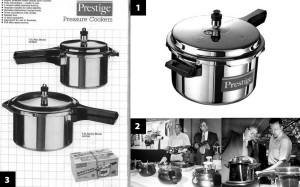 There is no question that Disneyland had a huge impact on the world of entertainment. From its inception, the Hollywood studios and amusement park owners simply did not understand Walt Disney’s concept of a theme park and collectively decided it would be a failure! Based more on the feel of Denmark’s Tivoli Gardens, Disneyland felt more like the idealized vision of the perfect village filled with magical fantasies. It also became the model for some of the suburban areas that came after. Of course, the fabulous fireworks in a wide array of vibrant colors always capped the end of the day.
There is no question that Disneyland had a huge impact on the world of entertainment. From its inception, the Hollywood studios and amusement park owners simply did not understand Walt Disney’s concept of a theme park and collectively decided it would be a failure! Based more on the feel of Denmark’s Tivoli Gardens, Disneyland felt more like the idealized vision of the perfect village filled with magical fantasies. It also became the model for some of the suburban areas that came after. Of course, the fabulous fireworks in a wide array of vibrant colors always capped the end of the day.consider this: A Dummy Post
 There is no question that Disneyland had a huge impact on the world of entertainment. From its inception, the Hollywood studios and amusement park owners simply did not understand Walt Disney’s concept of a theme park and collectively decided it would be a failure! Based more on the feel of Denmark’s Tivoli Gardens, Disneyland felt more like the idealized vision of the perfect village filled with magical fantasies. It also became the model for some of the suburban areas that came after. Of course, the fabulous fireworks in a wide array of vibrant colors always capped the end of the day.
There is no question that Disneyland had a huge impact on the world of entertainment. From its inception, the Hollywood studios and amusement park owners simply did not understand Walt Disney’s concept of a theme park and collectively decided it would be a failure! Based more on the feel of Denmark’s Tivoli Gardens, Disneyland felt more like the idealized vision of the perfect village filled with magical fantasies. It also became the model for some of the suburban areas that came after. Of course, the fabulous fireworks in a wide array of vibrant colors always capped the end of the day.Super Ram and Durga Woman: Contemporary Indian Comics
If I had a rupee for every time I’ve heard the sentence, “This is about the battle between good and evil”, I’d be a multi-millionaire. I could bet that every book that tells a story from Hindu Mythology has this sentence somewhere in its pages. It is a cliché I have truly come to hate, because it grossly and erroneously oversimplifies the truly complex stories of Hindu Mythology. So I was pretty dismayed when this phrase showed up as a tagline for a recent exhibition at the Los Angeles County Museum of Art.
Luckily, “Heroes & Villains: The Battle for Good in India’s Comics”, is a forgivable case of inappropriate titling. I completely sympathise with the exhibition’s curators, Julie Romain and Tushara Bindu Gude. Coming up with a title that bundles together Chitrakathi art from Paithan, Miniatures from Guler, Amar Chitra Katha, Wonder Woman, and Ramayan 3392 AD and Devi from Liquid Comics, must have been a pretty uphill task. But once you get past that unfortunate title wall, painted so stereotypically in fuchsia pink and orange, the richness and diversity of the material on display gives lie to any one-liner analysis of the fascinating development of comics in India.
Continue reading
I’m a Mac (Just a Regular Guy)
You can download an illustrated version of this essay here. (pdf, 1.02 MB)
– William Shakespeare, Romeo and Juliet, Act II, Scene II
The Many Macintoshes
Once upon a time, a Mackintosh was a rather unglamorous looking raincoat made in Britain. Then, on January 24, 1984, the word Macintosh (without the letter ‘k’) acquired a new meaning: a personal computer manufactured and sold by Apple Computers, Inc. This computer was sold with two applications developed by Apple: MacWrite and MacPaint. Thus was born the brilliant nickname that would stick to every subsequent computer product that Apple released – “Mac”. In both Apple’s products and their marketing, this nickname has played out in a delightfully unforeseen but meaningful way.
Continue reading
Pedicab Wala
Listen to me talk about Rickshaws in New York City, or download the file here (mp3, 6.45MB).
_________________________________________________________________________________
Thanks to Stan, Tony and Ismail. The music is “Main Rickshawala” from the film “Chhoti Behen” (1959)
The Belle of the Ball
The Tall Bank Building Sustainably Considered
In December 2007, a 255.5 ft architectural spire was added to the new Bank of America building at One Bryant Park, finally giving it its intended height of 1,200 ft. This made it the second tallest building, and the tallest glass‐walled skyscraper in New York City. However, its biggest claim to fame is something that is unfortunately not visible in the architectural renderings, or to the passer‐by on the street: it is being touted as the world’s greenest skyscraper. Continue reading
Celebrating Design
September is the best time to visit Kolkata, the capital city of West Bengal, India. In the gentle autumn weather the Bengalis celebrate a ten day festival in honour of their favourite diety: the ten-armed Mother Goddess Durga. There is private worship in every home, but each neighbourhood organizes public worship at a stall, or pandaal. These pandaals are elaborate affairs: ranging from small sheds to enormous halls that are several hundred square feet in area. They are designed and built by local artisans, and have the most diverse inspirations. Last year’s pandaal themes included Victorian, Tribal, Gandhi, and Harry Potter. The highlight of each pandaal is a large idol of the Goddess Durga, designed in keeping with the theme. The Harry Potter pandaal was shaped like Hogwarts castle and the idol had moons and stars on her sari.
Continue reading
My Pressure Cooker Fascination
Listen to me talk about pressure cookers, or download the file. (4.22 MB .mp3)
1. The ubiquitous aluminium Hawkins pressure cooker
2. The Hawkins Futura, introduced in 1985, became an instant design classic.
3. Typical publicity material that always comes in the pressure cooker carton: in this case, a recipe book for a Futura.
4. How do you open a Hawkins pressure cooker? Opening pressure cookers is never easy for first-timers, no matter what pressure cooker you buy.
1. The design of the stainless steel Prestige pressure cooker has changed very little over the years.
2. TTK Prestige’s senior management at new product launches in 2003 and 2004.
3. A page from a Prestige catalogue from the early 90’s.
Do you have any pressure cooker stories to share?
Revolution on a Keyboard
IBM’s place in history is secure, as one of the 20th century’s largest drivers of technology and purveyors of the most advanced products in electronics and computing. But their consumer products, even acclaimed seminal ones such as the Selectric typewriter or the IBM PC, never achieved the cult status accorded to the Olivetti Lettera 22 typewriter, or the Apple iMac G3. How did these objects, from much smaller competitors, create their cults?
The Japanese Total Design Idea
My conception of Japanese Society has been shaped mainly by films. For images of the traditional, rule-bound, society of aesthetes, there were Akira Kurosawa’s brilliant films, set in the age of the Samurai. To get the essence of a rapidly modernizing society that still retained its gentle traditional core, I saw Yasujiro Ozu, especially his masterpiece Tokyo Story (1953). For an outsider’s view of contemporary Tokyo, there was Wim Wenders’s Tokyo-Ga (1985); and for an insider’s conception of a fantasy Japanese world, there is, of course, Hayao Miyazaki. But to find an object that encapsulated all these ideas in one compact envelope of cuteness was completely beyond my expectations.
When I entered the Sanrio store on 42nd Street in New York, I was prepared to encounter a cult that I did not understand. Sure, I have little cousins who have Hello Kitty lunch boxes, and who tote tiny pink Hello Kitty bags, but I could not conceive how people of all sizes, ages, and genders found something they liked on shelf after shelf of Hello Kitty madness. Yet, there they were: picking out not just toys and stationery, but laptop cases, iPhone covers, and even rear view mirrors with a mouthless Kitty saying ‘Hello!’ to them. I joined them, scanning every item, not willing to believe that anything in all this madness could possibly appeal to me. But on a shelf right near the entrance to the store, I found it: a Hello Kitty Dairi-bina.











